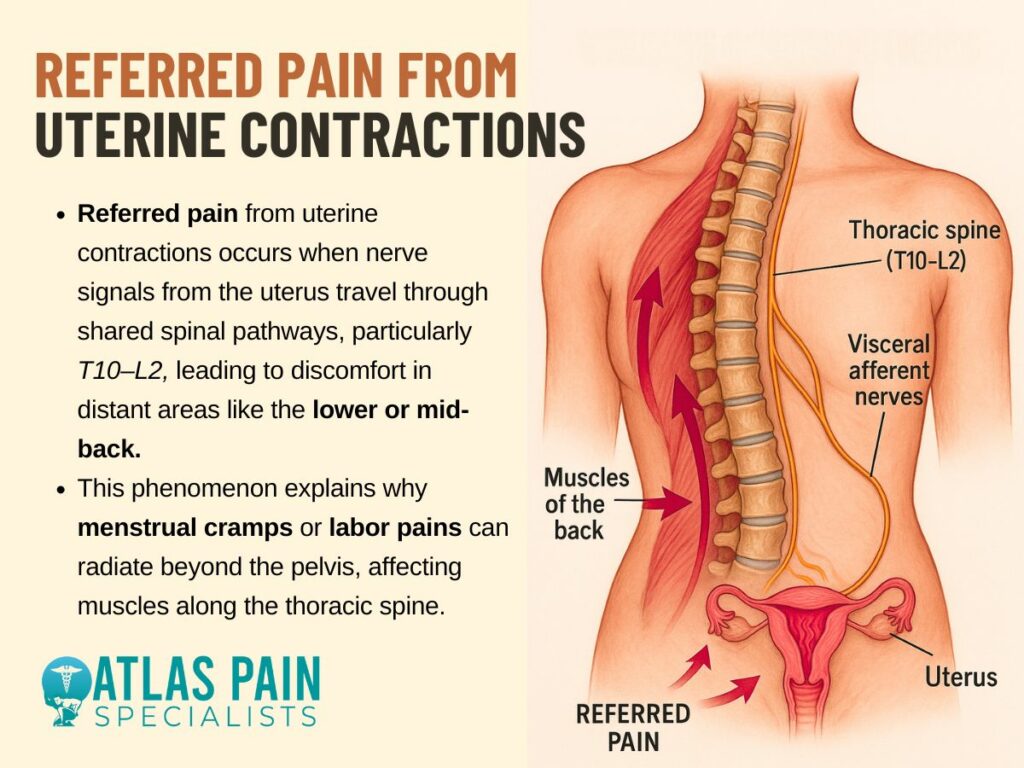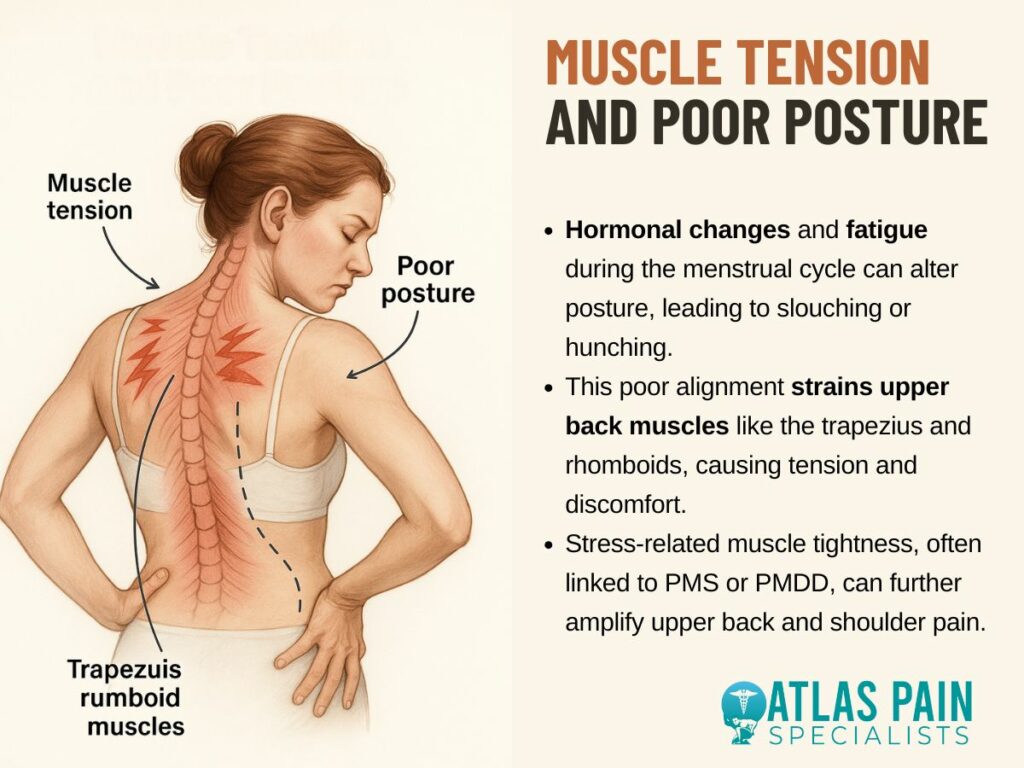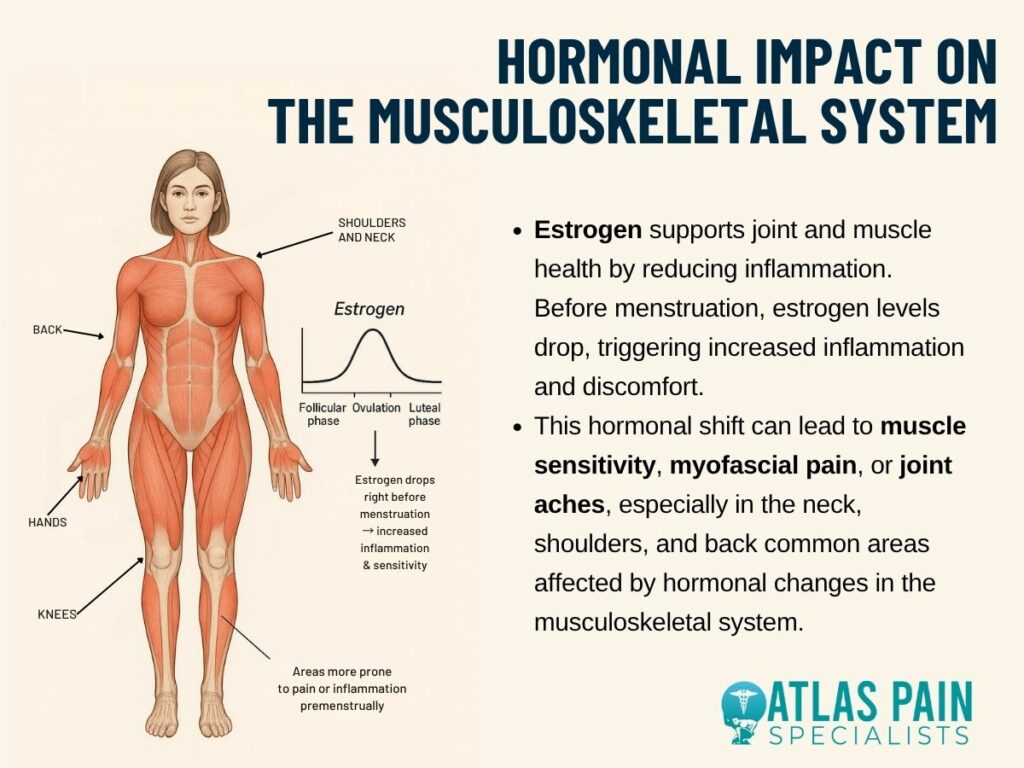

Why Does My Upper Back Hurt on My Period?
Upper back pain during your period is often caused by hormonal fluctuations, muscle tension, and poor posture related to menstrual symptoms. Menstruation is a complex biological process that can bring a wide range of physical and emotional effects including cramps, fatigue, mood swings, and sometimes surprising discomfort in the upper back. While lower abdominal and lower back pain are well-known period symptoms, upper back pain can be more unexpected and confusing.
If you’ve ever wondered, “Why does my upper back hurt on my period?” you’re not alone. This article explores the hormonal, muscular, and postural factors that contribute to this pain and offers practical strategies to help you manage it more comfortably.
Understanding Menstrual Pain
Understanding how hormones affect your body during menstruation can help explain many of the physical symptoms you experience, including pain. Hormonal fluctuations throughout your cycle play a key role in triggering and intensifying menstrual discomfort.
1. The Role of Hormones
Hormones like estrogen and progesterone regulate the menstrual cycle and fluctuate significantly before and during your period. A drop in these hormones, especially estrogen, can increase your sensitivity to pain and contribute to inflammation and muscle tension.
2. Prostaglandins and Cramping
Prostaglandins are hormone-like substances released by the uterus to help shed its lining. High levels of prostaglandins can cause stronger uterine contractions, which not only lead to cramps but can also radiate discomfort to the lower and upper back.
3. Impact on Mood and Stress
Hormonal shifts can also influence mood, increasing feelings of anxiety or irritability. Elevated stress levels often lead to muscle tightness, especially in the shoulders and upper back, adding to physical discomfort.
By understanding the hormonal processes behind your menstrual cycle, you can better recognize the causes of pain and find targeted ways to manage it more effectively.
Common Causes of Upper Back Pain During Menstruation
Upper back pain during menstruation may not be as widely discussed as lower back or abdominal cramps, but it's a fairly common and often overlooked symptom. Understanding the possible causes can help you manage this discomfort more effectively each cycle.
1. Referred Pain from Uterine Contractions
Though the uterus is located in the lower abdomen, the nerves and muscles it affects can create a domino effect throughout the torso. This phenomenon, known as referred pain, means that pain originating in one area is felt in another. Severe uterine cramping may irritate nerves connected to muscles in the mid-to-upper back, especially around the thoracic spine.

2. Muscle Tension and Poor Posture
Hormonal changes can cause bloating, breast tenderness, and fatigue, which may subconsciously alter your posture. Slouching or hunching over—particularly when lying in bed or using a heating pad—can strain the trapezius and rhomboid muscles, leading to upper back pain.
Muscle tension is also more likely when you’re stressed, and many people experience heightened anxiety or irritability during their menstrual cycle due to premenstrual syndrome (PMS) or premenstrual dysphoric disorder (PMDD).

3. Hormonal Impact on the Musculoskeletal System
Estrogen has anti-inflammatory properties and helps maintain muscle and joint health. As estrogen levels fall right before your period, inflammation may rise and muscle pain may become more noticeable. Some women experience myofascial pain or joint sensitivity, particularly in the back, shoulders, and neck.

4. Breast Swelling and Upper Thoracic Strain
Hormonal fluctuations can lead to breast engorgement or tenderness before and during your period. Increased breast size or weight can pull the upper back and shoulder muscles forward, placing extra strain on the thoracic spine and scapular region.
5. Underlying Conditions Exacerbated by Menstruation
Conditions like endometriosis, fibromyalgia, or chronic back disorders can worsen with hormonal shifts. Endometrial tissue may implant near the diaphragm or spine, which could refer pain to the upper back during menstruation.
Similarly, fibromyalgia sufferers often experience intensified musculoskeletal pain during their cycle.
6. Stress and Anxiety
The menstrual period can be a time of increased emotional sensitivity, stress, and anxiety for many. Psychological stress can manifest physically as increased muscle tension, particularly in the neck, shoulders, and upper back.
The body's "fight or flight" response, when activated by stress, can lead to chronic muscle clenching and pain.
While upper back pain during menstruation can be frustrating, it’s often a result of natural hormonal and physical changes. Identifying the cause is the first step toward finding effective relief and improving comfort during your cycle.
Other Contributing Factors
In addition to hormonal shifts and uterine activity, several other factors can contribute to upper back pain during menstruation. Recognizing these additional influences can help you address the pain more holistically.
1. Dehydration
Not drinking enough water, which can happen during your period, can lead to muscle cramps and worsen existing aches. Proper hydration is vital for muscle function and comfort.
2. Dietary Factors
Eating foods high in sugar, processed ingredients, or unhealthy fats can increase inflammation throughout your body. These dietary choices might intensify muscle aches, including those in your upper back, during your period.
3. Sleep Disturbances
Pain, discomfort, or hormonal shifts can disrupt sleep during menstruation. Poor sleep quality prevents your body from recovering, making muscle aches more noticeable and increasing your sensitivity to pain.
4. Underlying Medical Conditions
Pre-existing conditions like scoliosis, fibromyalgia, or even endometriosis can see their symptoms worsen during menstruation, leading to more pronounced upper back pain. Rarely, digestive issues like IBS or gallstones might also cause referred pain in the upper back.
Being aware of these contributing factors can help you take a more comprehensive approach to managing upper back pain. With a combination of lifestyle adjustments and targeted care, you can reduce discomfort and improve your overall well-being during your period.
When to Seek Medical Attention
While upper back pain during menstruation is often manageable with lifestyle changes and self-care, there are times when it could indicate something more serious. Knowing when to consult a healthcare provider is important for your overall health and peace of mind.
1. Persistent or Severe Pain
If your upper back pain is intense, lasts beyond your period, or interferes with daily activities, it could signal an underlying issue. Chronic or worsening pain should always be evaluated by a healthcare professional.
2. Accompanying Unusual Symptoms:
If your back pain is accompanied by symptoms like fever, numbness, chest pain, or difficulty breathing, it may be unrelated to menstruation and require immediate medical attention. These signs could point to conditions like infections or nerve problems.
3, No Relief from Over-the-Counter Treatments
When common remedies like heat, stretching, or pain relievers fail to provide relief, it might be time to seek medical advice. Ineffectiveness of standard treatments can suggest a need for further investigation.
Being aware of these warning signs ensures you don't overlook potentially serious health concerns. If something feels unusual or unmanageable, it’s always best to consult a healthcare provider for proper evaluation and guidance.
Coping Strategies and Remedies
Managing upper back pain during your period involves both immediate relief techniques and long-term lifestyle adjustments. Incorporating a few simple habits can help ease discomfort and improve your overall menstrual experience.
1. Heat Therapy
Applying a heating pad or warm compress to your upper back can relax tight muscles and increase blood flow. This soothing method often provides quick relief from tension and soreness.
2. Stretching and Gentle Exercise
Light activities like yoga, walking, or targeted stretching can reduce stiffness and improve posture. Movement also helps release endorphins, which act as natural painkillers.
3. Over-the-Counter Pain Relief
Nonsteroidal anti-inflammatory drugs (NSAIDs), such as ibuprofen, can reduce inflammation and alleviate both menstrual cramps and back pain. Be sure to follow dosage instructions or consult a healthcare provider.
4. Posture Awareness
Maintaining good posture, especially when sitting for long periods, can prevent added strain on the upper back. Using ergonomic chairs or lumbar supports may also be helpful.
5. Stress Reduction Techniques
Practices like deep breathing, meditation, or massage can help reduce emotional tension that often contributes to physical pain. Managing stress levels can minimize muscle tightness in the shoulders and back.
Using a combination of these strategies can make a noticeable difference in your comfort during menstruation. By listening to your body and adopting supportive habits, you can reduce pain and feel more in control of your cycle.
Managing Upper Back Pain During Your Period
Managing upper back pain during your period involves a mix of practical self-care techniques and mindful lifestyle choices. By addressing both the physical and emotional aspects of pain, you can significantly reduce discomfort and improve your overall well-being.
1. Maintain Regular Exercise
Engaging in consistent, moderate exercise helps strengthen back muscles and improve circulation, which can reduce menstrual-related pain. Activities like swimming, walking, or yoga are particularly beneficial for easing muscle tension.
2. Stay Hydrated and Eat Well
Proper hydration and a balanced diet rich in anti-inflammatory foods can help minimize bloating and muscle cramps. Avoiding excessive caffeine and salty foods may also reduce discomfort.
3. Prioritize Rest and Sleep
Getting enough quality sleep supports your body’s healing processes and reduces stress, which can exacerbate pain. Establishing a calming bedtime routine can improve sleep during your period.
4. Use Supportive Pillows and Ergonomics
Sleeping with pillows that support your back and maintaining good posture at work or home can lessen strain on your upper back. Ergonomic adjustments help maintain spinal alignment and prevent muscle fatigue.
By combining these management techniques, you can create a personalized approach to ease upper back pain during your menstrual cycle. Consistency and self-awareness are key to finding relief and enhancing your comfort each month.
Navigating Period-Related Upper Back Pain: A Summary
Upper back pain during your period is a common but often misunderstood symptom influenced by a combination of hormonal changes, uterine activity, muscle tension, and emotional factors. While it may feel confusing or unexpected compared to typical menstrual cramps, recognizing the root causes can help you manage the discomfort more effectively.
Simple lifestyle adjustments, stress management, and self-care techniques can make a significant difference in easing this pain. Being aware of why upper back pain occurs during menstruation allows you to take control of your symptoms and improve your menstrual health.
If the pain is severe or persistent, seeking medical advice is important to rule out other issues. With the right approach, managing this pain can become easier each cycle.
About Dr. Sean Ormond



